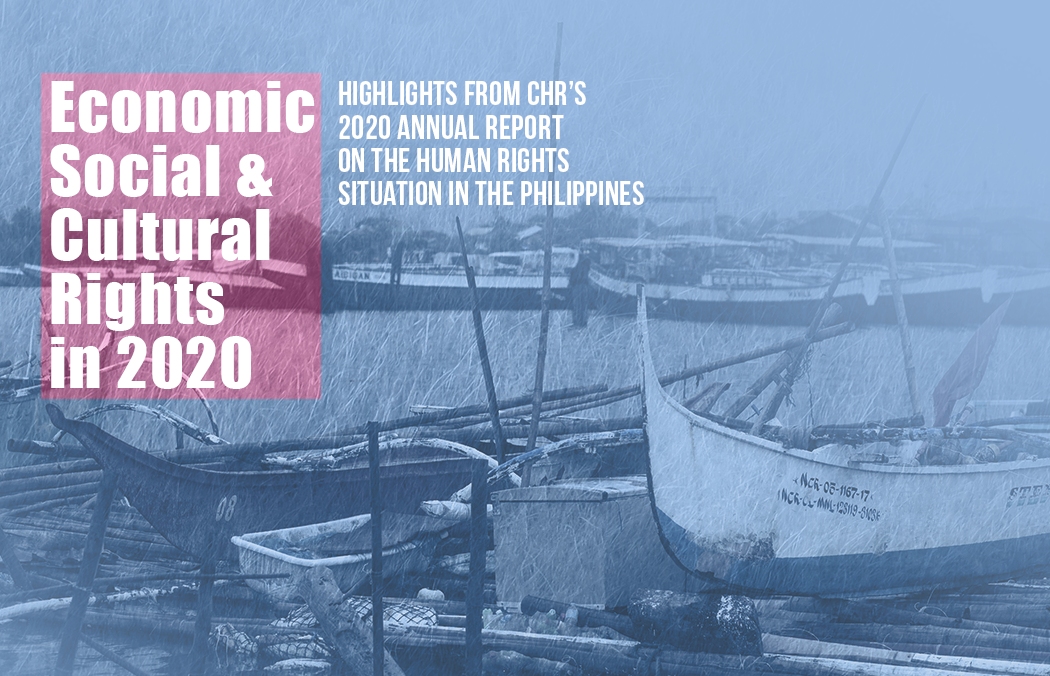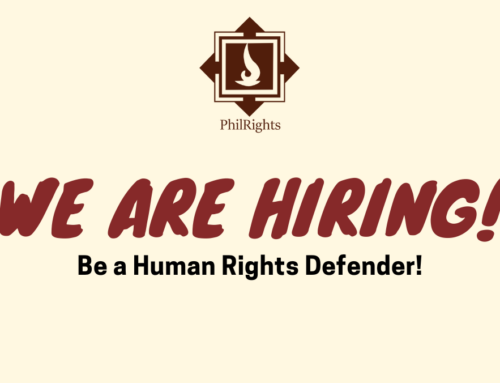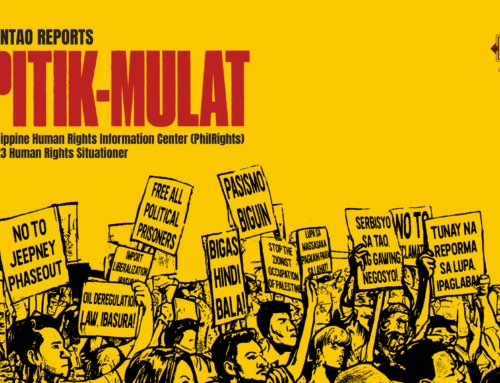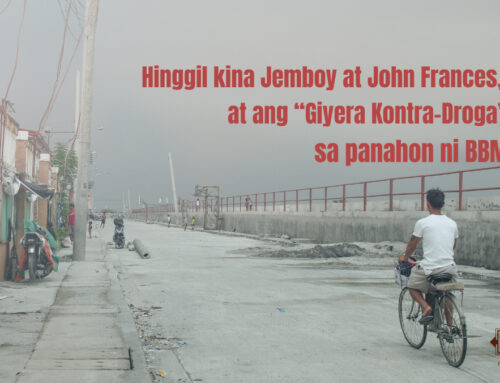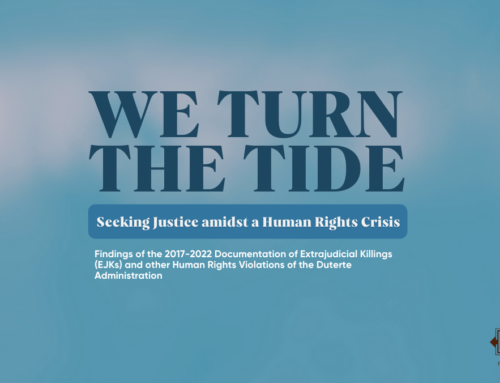by Isaiah Castro
Part 1: National Economic, Social, and Cultural Rights at an All-time Low
The Commission on Human Rights (CHR) released in August its annual report on the country’s human rights situation for 2020. Their findings reveal a sobering look at the Philippine government’s COVID-19 response’s hits and misses.
The Philippines’ national response was heavily criticized for being initially lax and marred by a severe lack of coordination among enforcing units. In January 2020, the Department of Health (DOH) reported the country’s first COVID-19 case; by March, local transmission was confirmed. It took two months after the first case was reported before President Rodrigo Duterte convened the Inter-Agency Task Force for the Management of Emerging Infectious Diseases (IATF). On March 12, the IATF agreed to hoist Code Red Sublevel 2, the maximum national alert level system, over the country. These consequently compelled workplaces to operate on a skeletal level and suspended both foreign and domestic travel except for essential personnel and cargo.
Public Health in Peril
CHR’s report recognized the government’s four-fold obligation to ensure that delivery of emergency health services (1) is on a non-discriminatory basis, (2) provides for essential drugs, (3) is equitably distributed, and (4) is adopted and implemented through health programs and complementary legal instruments. The prevailing challenge, however, as evinced by testimonies and news stories, is COVID-19’s “prohibitive” costs of treatment which places “enormous pressure” on the State’s public health mandate.
Despite promising that daily testing capacity would reach 30,000 by end of May 2020, DOH only achieved 27,800 by August, and even faced further flak when reports surfaced about supposed prioritization for several public officials and their families instead of the most vulnerable and medical workers.
The Philippine Health Insurance Corporation (PhilHealth) paid full coverage for the confinement of COVID-19 patients from February 1 to April 14 2020, but an alleged 15-billion-peso corruption controversy erupted in August and cast a shadow on the agency’s credibility. CHR called for an immediate and independent investigation, pointing out that “reforms in political structures, rule of law, and governance are vital for the healthcare system to work effectively and efficiently.”
Since the Philippine government adopted what came to be the longest uninterrupted quarantine in the world, another looming issue CHR noted is how this “put a huge toll” on the public’s mental health situation. The agency cited a surge in calls made to suicide prevention hotlines per DOH and World Health Organization (WHO) data.
A May 2020 study by the Social Weather Station showed that the pandemic and its socioeconomic effects brought great stress to 55 percent of the surveyed working-age Filipinos, and 34 percent experienced “much stress.” Of those who experienced great stress, at least 4.2 million families, or 16.7 percent of those surveyed, experienced involuntary hunger due to insufficiency of food for consumption. Although the government already passed a national Mental Health Act in 2017, prioritization of physical health, isolations due to lockdowns, and an overall dismal sense of the future pushed mental health to the margins.
Rather than be protected and appreciated for the overwhelming service they do, medical workers have been subject to stigma, abuse, and discrimination due to widespread misbelief that they have become carriers of the disease. The IATF and CHR urged local government units to probe into and prevent escalation of cases of physical violence. Lack of government support and unjust treatment have endangered morale among healthcare workers, yet their existence remains as crucial as ever. To wit, the doctor-to-patient ratio in the country currently stands at 1:40,000, far from the ideal 1:10,000.
CHR expressed “deep concern” with the rising number of healthcare workers being infected and succumbing to COVID-19. WHO earlier sounded that alarm after reports showed 15 percent of confirmed COVID-19 cases in the Philippines were medical personnel, increasingly far from the 2-3 percent equivalent among Western Pacific nations. Lastly, CHR urged the DOH to ensure that more laboratories are equipped and accredited to conduct RT-PCR tests, and that purchase and transportation of protective equipment and other life-saving devices are done with utmost efficiency and transparency.
READ: Rights-based Approach to COVID-19 Emergency Response: Highlights
Social Security for Struggling Sectors
In April 2020, President Duterte boasted that the administration’s planned social amelioration program (SAP) was the “largest in the country’s history.” A few days prior, Congress approved the three-month Bayanihan to Heal as One Act, which granted the Executive additional powers to spearhead the national COVID-19 response. These included the power to reallocate 275-billion pesos from the national budget and temporarily takeover private utilities when public interest requires.
The government soon began releasing 5,000- to 8,000-pesos monthly cash subsidies to low-income families for months April and May under SAP. This mass distribution faced delays and irregularities due to bureaucratic red taping and rampant corruption in local government units. In September, Congress approved the follow-up Bayanihan to Recover as One Act to continue the government’s aims of national recovery, but it has been largely criticized for placing greater emphasis on infrastructure and transport modernization instead of health, sectoral protection, and rehabilitation.
According to the Philippine Statistics Authority, unemployment soared to 17.7 percent in April 2020, nearly a month into sweeping lockdowns that plunged the country’s economic growth while pushing poverty rates to new highs. Stories of stranded construction workers who were forced to walk their way back to provinces and public utility drivers who had to beg for alms along Rizal Avenue to fend for their families’ needs flooded the news. Quarantine measures downsized offices to skeletal workforces or shut them down altogether, causing a reduction in national output from the service sector, primarily from the wholesale, retail, and other sub-sectors that include hospitality services and entertainment. CHR also called attention to the conditions for informal economy workers who face higher exposure to health and safety risks with no income fallback options.
OFWs and migrant workers, likewise, were unable to escape the pandemic’s scope of ruin. By the end of September 2020, the Department of Foreign Affairs repatriated about 204,481 OFWs affected by economic downturn in all parts of the globe, a portion of which were granted hotel accommodation and other assistance while waiting for their test results. The Overseas Workers Welfare Administration also resumed its livelihood program for distressed OFWs who were sent back to their hometowns. CHR received and referred at least 38 cases of migrant workers’ labor concerns to relevant authorities.
However, the brunt of the pandemic’s weight was felt by the most basic sectors. CHR acknowledged that drastic changes in lockdown protocol levels have greatly impacted the ability of farmers and fisherfolk to sell their products and tend to their farms and fishing grounds. Prices of palay, or unhusked rice, continue to plummet due to both the pandemic and Rice Tariffication Law. Besides these, African swine fever infections continued to spread, infect, and kill valued livestock in Mindanao. CHR reported that by June 2020, only 46.31 percent, or a total of 18,527 of the government’s target small farmers and fisherfolk, were given cash assistance and access to lending conduits. Civil society and youth groups have taken initiatives to help farmers salvage their crops from rotting, such as setting up online platforms or markets-on-wheels to bridge the gap between producers and consumers.
Read: The Killing State: Duterte’s Legacy of Violence
Indigenous minorities also faced specific problems going into the pandemic. A little more than a week after the declaration of the Luzon-wide enhanced community quarantine in March 2020, CHR received complaints from Mangyan communities, especially farmers, who experienced difficulty in traversing farm-to-market roads due to proliferation of police and military checkpoints. Eco-tourism revenues, supposedly allotted for local sustenance, biosecurity, and tamaraw preservation, were depleted as travel was prohibited. Living in far-flung areas, Mangyans do not have immediate access to healthcare, supplies, safe water, and sanitation. CHR even raised a concern that a lot of IPs have experienced discrimination first-hand when availing of health services.
Moreover, CHR continued to register attacks on indigenous people and their leaders, which often came in the form of red-tagging. In ancestral Mindanao, the increasingly brutal conflict between the CPP-NPA and the paramilitary groups supported by the military leave the largely uneducated, hapless majority caught in the crossfires. Militarization in these traditional farming areas resulted in security issues and hindered agricultural production. There are also records of continuing development aggression, overlapping and conflicting land claims, and Indigenous Peoples Mandatory Representatives not being allowed to assume office. All of these threaten IP’s rights to ancestral domain and self-determination, according to the CHR, and are aggravated by “fear, poverty, government neglect, and decades of exploitation.”
These sharp narratives and the data backing them are but a glimpse into how the effects of the pandemic, health- and economy-wise, have become commonplace across different sectors, while some occurrences remain unique to the conditions of other groups, notably like that of indigenous communities. All these present a challenge to policy-making bodies and civil society: public decisions before and after the 2022 elections should account for the particular experience of marginalized groups and pave the way for rights-based action and lasting structural reforms towards a meaningful better normal for everyone.
Read: Highlights: National Indigenous Women Gathering 2021
On part two, we take a look at the state of education and the environment in 2020, according to the CHR 2020 Human Rights situation report.



